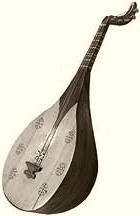Barbat (lute)
 |
|
| Classification | |
|---|---|
| Related instruments | |
The barbat (Persian: بربط) or barbud was a lute of possibly Central Asian origin. As a two-stringed lute, the barbat was an important instrument of the Arab Ghassanids in pre-Islamic times. Many instruments such as the Arabic oud are derived from the barbat. The modern Persian Barbat is almost identical to the oud, although differences include a smaller body, longer neck and a slightly raised fingerboard.
The barbat is one of the oldest instruments in the world, and probably originated in Central Asia. The earliest image of the barbat dates back to the 1st century BC from ancient northern Bactria, while a more "clear cut" depiction of the barbat from Gandhara sculpture dates to the 2nd-4th centuries AD. According to Encyclopedia Iranica, this type of instrument could have been introduced by the Kushans and was later adopted by the Persians. By the 7th century, the barbat was developed by the Sassanid Persians into a rud (lit. stringed instrument) which after the Islamic Conquest of Persia was Arabized into its current form, called the oud. After the tanbur, it is the oldest string instrument in Iran.
The instrument was abolished in the Safavid period for an unknown reason (perhaps due to religious fanaticism), even until recent decades.
It is possible that the earliest ouds were carved from a solid piece of wood in a similar manner to the barbat. By the time of the Moorish period in Spain, the body was in its characteristic staved wood vaulted back design. This innovation may have resulted in the name for the oud (the word means "wood" or "flexible stick"), the top was made of wood as opposed to the skin of earlier lutes, also the vaulted back that provided the model for the European lute was constructed from many steam-bent "flexible sticks". After the instrument was taken to the Arab world, the body became larger as a possible result of the new method of construction, while the neck became proportionally shorter.
...
Wikipedia
